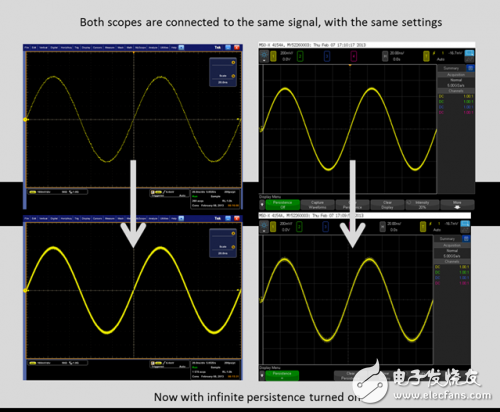The oscilloscope waveform shows the true electrical signal. When evaluating oscilloscope performance, you can examine its ability to display the same shape as the target signal. Assuming the oscilloscope has enough basic technical specifications - such as bandwidth, sample rate and equal frequency response, should the oscilloscope display a coarse or fine waveform better? The answer to this question is the same as most engineering questions: "depending on the situation." Now let's examine the properties of the oscilloscope and signals. These properties help the user determine whether it is a coarse or a fine waveform. Two key attributes allow the user to understand the ability of their oscilloscope to display the target signal, which is the update rate and noise. The update rate represents the number of waveforms acquired, processed, and displayed by the oscilloscope in less than 1 second. The higher the update rate, the faster the oscilloscope can display the signal under test. The lower the update rate, the longer the oscilloscope will display the details associated with a particular waveform. Currently, the oscilloscope's update rate ranges from 1 million waveforms per second to 1 waveform per second. Simply change the oscilloscope settings and the same oscilloscope can display different speed ranges. The update rate is affected by multiple oscilloscope settings, including changing the depth of the acquisition memory, which can have a significant impact on memory depth. Let's take a look at a simple example. The top half of Figure 1 shows an oscilloscope with equal bandwidth produced by two well-known manufacturers. The oscilloscope runs continuously and is connected to the exact same 10 MHz sine wave. One of the oscilloscopes shows a thicker waveform and the other shows a thinner waveform. This can result in different measured values. Which one is more precise? One of the biggest differences between the two oscilloscopes is the update rate. Using the same settings, one of the oscilloscopes has an update rate of 1 million waveforms per second, which is 16,000 times faster than the update rate of the other oscilloscope. How does this affect the waveform? The bottom half of Figure 1 shows how the two oscilloscopes connected to the same signal will be displayed when infinite persistence is turned on. Both oscilloscopes will create images with longer durations. After 10 seconds, the oscilloscope shows the same waveform shape and waveform thickness. In this case, the initial oscilloscope with a higher data rate can display a thicker waveform and more clearly represent the display content of each oscilloscope. By turning on infinite afterglow, we can quickly evaluate. Figure 1. Two oscilloscopes with equal bandwidth and approximate noise are connected to the same signal. The noise of the two oscilloscopes is similar. The screenshot above shows the Tek DPO5104A, which has a very narrow waveform and provides more detail. The Agilent DSOX4104A displays a wider waveform. Why is there such a difference? The reason is the update rate. Turn on infinite persistence and wait 10 seconds. Both oscilloscopes display the same thickness. The Agilent oscilloscope has an update rate of 1 million waveforms per second, while the Tek oscilloscope has an update rate of only 60 waveforms per second in normal mode. The thickness of the waveform is related to the amount of noise added by the oscilloscope to the initial signal. Chinese and English in the picture Both scopes are connected to the same signal, with the same setTIngs Now with infinite persistence turned on. Two oscilloscopes are connected to the same signal, using the same settings Now open the infinite afterglow. Watch & Apple Airtag Screen Protector TPU Watch Screen Protector, Transparent ​Watch Screen Protector, Watch Screen Protector Case, Apple Watch Case, Apple Watch Case Protector, Apple Watch Protective Case Shenzhen Jianjiantong Technology Co., Ltd. , https://www.hydrogelprotectivefilm.com